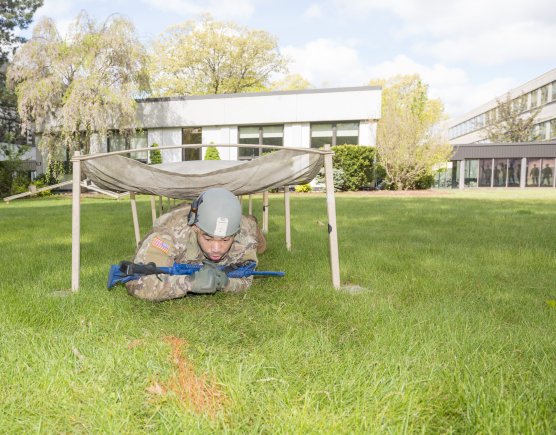
July 12, 2019 – Researchers from the Combat Capabilities Development Command Soldier Center (CCDC SC) — formerly the Natick Soldier Research, Development and Engineering Center, located in Natick, MA — are supporting ongoing testing of an augmented reality headset called the ‘Integrated Visual Augmentation System’, or IVAS. CCDC SC is also providing test design guidance for the effort.
Specifically, as part of ongoing human factors testing, CCDC SC’s Human Factors Team and Biomechanics Team are providing logistical and subject matter expertise to Product Manager IVAS, part of Program Executive Office Soldier (PEO Soldier), and “industry”, according to the Army.
Industry in this instance, of course, being Microsoft, which was awarded the USD $479 million contract with the US Army in November 2018 for the development and supply of 2,550 IVAS prototypes. The Army is expecting these prototypes to evolve in to a tailored military solution over the course of the contract, with one aim being to design IVAS to increase Soldier lethality, mobility and situational awareness by providing enhanced night and thermal vision capabilities, map displays, and data collection capabilities.
The test team — comprised of members from Product Manager IVAS, industry, and CCDC SC — is using a mobility assessment tool called the ‘Load Effects Assessment Program — Army’ (LEAP-A) to evaluate IVAS.
According to the US Army, LEAP-A provides researchers with a reliable method to measure the impact of clothing and individual equipment on Soldier performance. The LEAP-A platform consists of a series of obstacles and mission-relevant tasks/activities that resemble challenges that warfighters face in current combat situations.
During a testing event held in May at CCDC SC, researchers used the LEAP-A obstacle course to test two prototype versions of the IVAS. Researchers focused on the stability of the systems on the heads/helmets of Soldiers.
“The prototypes are being tested for data on Soldier head movement during the performance of physical tasks,” said Blake Mitchell, an engineering psychologist and team leader for the Human Factors Team in the CCDC Soldier Center’s Soldier Performance Optimization Directorate. “Studying the relationship between the head and the helmet and the equipment will help improve the product.”
CCDC SC stated that it is dedicated to using science and technology to ensure its country’s warfighters are “optimized, protected, and lethal”. CCDC SC supports all of the Army’s Modernization efforts, with the Soldier Lethality and Synthetic Training Environment Cross Functional Teams being the CCDC SC’s chief areas of focus. The center’s science and engineering expertise are combined with collaborations with industry, DOD, and academia to advance Soldier and squad performance. The center supports the Army as it transforms from being adaptive, to driving innovation to support a Multi-Domain Operations (MDO) Capable Force by 2028 and a MDO Ready Force by 2035.
Master Sergeant Marc Krugh, senior enlisted advisor to PM IVAS, PEO Soldier, noted the importance of CCDC SC’s expertise: “Utilizing CCDC SC at Natick allows us to work with government experts and industry experts on a facility that has stood the test of time with proven results to increasing Soldier lethality.” Krugh added: “The LEAP-A course allows for consistency in human factors evaluations of form, fit, and function of the IVAS prototypes.”
In addition to LEAP-A testing, the event held at CCDC SC also included 3D scanning of Soldiers with different weapon and optic systems to facilitate compatibility in future development of the IVAS. Microsoft also conducted extensive interviews with Soldiers regarding load carriage and load placement.
“Soldier input is a big part of the effort,” said Mitchell. Krugh added: “Soldier knowledge, expertise and experience cannot be replicated in a lab or on a computer.”
Microsoft has continued to learn directly from Soldiers who will be using the device and will continue to do so as development of the hardware and software for IVAS progresses.
“Our culture is grounded in understanding the people who use our products,” said Y.K. Cheong, Principal Human Factors Engineer at Microsoft. “We want to be Soldier-centered, to engage directly with Soldiers in a representative ecology. By working with Natick/CCDC SC, we can design toward improving Soldier performance and optimizing comfort.”
CCDC SC is expected to participate in additional IVAS testing events in the future.
Image credit: US Army/
About the author
Sam is the Founder and Managing Editor of Auganix. With a background in research and report writing, he has been covering XR industry news for the past seven years.
